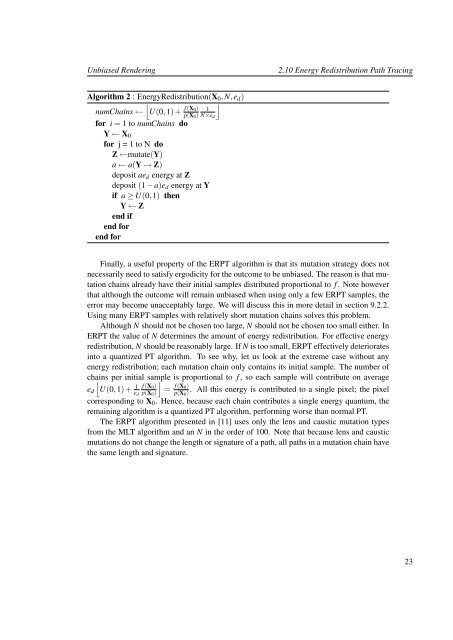Master Thesis - Computer Graphics and Visualization - TU Delft
Master Thesis - Computer Graphics and Visualization - TU Delft
Master Thesis - Computer Graphics and Visualization - TU Delft
You also want an ePaper? Increase the reach of your titles
YUMPU automatically turns print PDFs into web optimized ePapers that Google loves.
Unbiased Rendering 2.10 Energy Redistribution Path Tracing<br />
Algorithm 2 : EnergyRedistribution(X0,N,ed)<br />
<br />
<br />
f (X0) 1<br />
numChains ← U(0,1) + p(X0) N×ed<br />
for i = 1 to numChains do<br />
Y ← X0<br />
for j = 1 to N do<br />
Z ←mutate(Y)<br />
a ← a(Y → Z)<br />
deposit aed energy at Z<br />
deposit (1 − a)ed energy at Y<br />
if a ≥ U(0,1) then<br />
Y ← Z<br />
end if<br />
end for<br />
end for<br />
Finally, a useful property of the ERPT algorithm is that its mutation strategy does not<br />
necessarily need to satisfy ergodicity for the outcome to be unbiased. The reason is that mutation<br />
chains already have their initial samples distributed proportional to f . Note however<br />
that although the outcome will remain unbiased when using only a few ERPT samples, the<br />
error may become unacceptably large. We will discuss this in more detail in section 9.2.2.<br />
Using many ERPT samples with relatively short mutation chains solves this problem.<br />
Although N should not be chosen too large, N should not be chosen too small either. In<br />
ERPT the value of N determines the amount of energy redistribution. For effective energy<br />
redistribution, N should be reasonably large. If N is too small, ERPT effectively deteriorates<br />
into a quantized PT algorithm. To see why, let us look at the extreme case without any<br />
energy redistribution; each mutation chain only contains its initial sample. The number of<br />
chains per initial sample is proportional to f , so each sample will contribute on average<br />
ed U(0,1) + 1<br />
<br />
f (X0)<br />
ed p(X0) = f (X0)<br />
p(X0) . All this energy is contributed to a single pixel; the pixel<br />
corresponding to X0. Hence, because each chain contributes a single energy quantum, the<br />
remaining algorithm is a quantized PT algorithm, performing worse than normal PT.<br />
The ERPT algorithm presented in [11] uses only the lens <strong>and</strong> caustic mutation types<br />
from the MLT algorithm <strong>and</strong> an N in the order of 100. Note that because lens <strong>and</strong> caustic<br />
mutations do not change the length or signature of a path, all paths in a mutation chain have<br />
the same length <strong>and</strong> signature.<br />
23
















